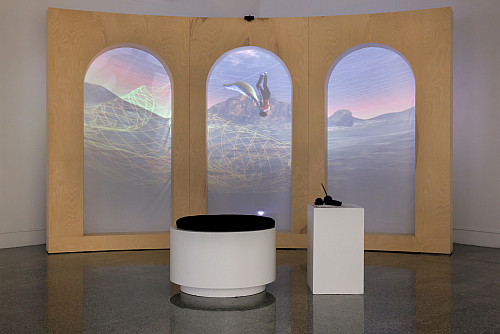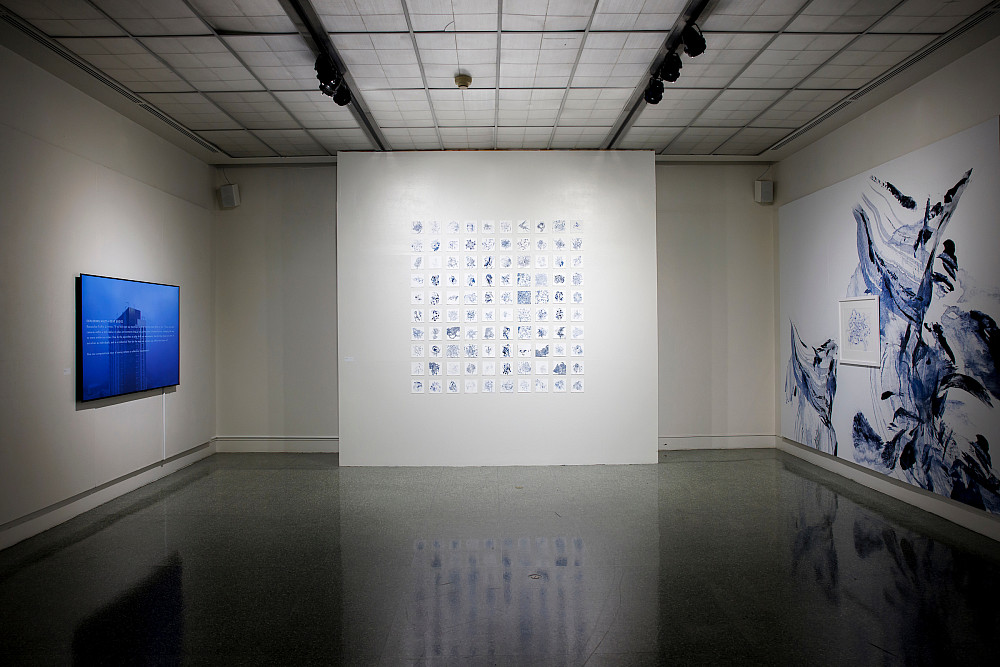New technologies have received both praise and ire from society for centuries, from criticisms surrounding “reading fever” in the late 18th century to condemnations of how the automobile, television, video games and the internet would lead to the downfall of society. Now, artificial intelligence has emerged, prompting similar questions around whether it could help or hinder civilization — questions that are explored by a new art exhibition at Indiana University Bloomington.
“Blurring the Lines: Art at the Intersection of Human and Artificial Creativity” invites viewers to consider the effects of AI on art and culture. The exhibition spotlights the challenges of a new technological frontier while demonstrating how the arts and humanities can be applied to science and technology to create more well-rounded solutions to society’s issues. The exhibition will be open, free to the public, through Nov. 16 at the Grunwald Gallery of Art in the Fine Arts Building.
“Blurring the Lines” grew from the AI + Digital Futures initiative, part of the overarching IU Arts and Humanities Futures program that advances research and creative projects that address contemporary issues. While the growing prevalence of AI presents new challenges — such as “deep fakes” that spread misinformation, or fears around the replacement of human artistry — the exhibition’s curators have focused on examining AI rather than rejecting it.
“This exhibition is fruitful ground for conversation, and in that respect, we broaden our imagination of what AI in the arts might look like,” said Arthur Liou, director of the AI + Digital Futures initiative and the Herman B Wells Endowed Professor of Digital Art at the IU Eskenazi School of Art, Architecture + Design.
“Blurring the Lines” co-curators Linda Tien, director of the Grunwald Gallery, and Caleb Weintraub, associate professor of painting at the Eskenazi School, cast a wide net when calling for submissions. Works in the exhibition represent a varied range of mediums and disciplines, from artist Kexin Liu’s immersive “3607-Bacterial Soundscape,” which merges microbiology with AI-generated audio, to a thought-provoking self-portrait painted by the humanoid robot, Ai-Da.
“We started from a place of a very broad understanding of what art is and what creativity is,” Tien said.
Many pieces in “Blurring the Lines” act as cultural commentary.
“I.A. Suzie,” a piece by Lauren Lee McCarthy and David Leonard, explores the role of AI in elder care. Adam Chau’s piece, “Generated Love,” depicts gay relationships in the style of Ming Dynasty porcelain to show a historical lack of representation while pointing out defects in the diversity and accuracy of AI-generated imagery.
“Some of the work is critical of the technology and reveals gaps or biases in the data,” said Weintraub, who co-taught “AI in the Studio,” the university’s first undergraduate course that addressed AI as a tool in artistic practice. Weintraub also led IU’s summit on “Creativity in the Age of AI” in 2023.
Weintraub said those biases are demonstrated by several works, including “Dark Matters” by Johann Diedrick. The computational video piece visually represents how language models used to create voice recognition software like Alexa or Siri were missing data from diverse voices when they were created.
“People who spoke differently from an Anglo accent would have to code switch to be understood by the device,” Weintraub said.
Megan Young, lecturer and digital art area head at the Eskenazi School, created “carry:root,” a visually compelling, interactive chatbot that demonstrates how AI can be used as a digital cultural archive and a humanities-based learning tool. Trained by conversations with women across the globe who experienced displacement and forced migration, “Carry” can chat with visitors about “her” journeys, even providing emotional depth in a conversational tone.
By collecting and amplifying the stories of women affected by migration, Young’s “carry:root” contributes to the preservation of cultural narratives that may otherwise be overlooked.
“I’m still talking with women from around the world about their experience with displacement,” Young said. “As the project gets more traction, I’m working with grassroots organizations that serve communities impacted by displacement and having conversations with people through a larger lens.”
Young’s work was funded by a fellowship awarded by the Eskenazi Technology Innovation Lab, which works in partnership with the AI + Digital Futures Initiative. She collaborated with researchers and students at the IU Luddy School of Informatics, Computing and Engineering to develop the AI using Python and Visual Studio Code, natural language-processing and retrieval-augmented generation techniques.
Another striking exhibit in the show is “DOUG” — “Drawing Operations Unit Generation_X” — robots programmed and built by world-renowned artist and Eskenazi School alum Sougwen Chung. A former research fellow at MIT and a pioneer of human and machine collaboration, Chung created “DOUG” to synchronously draw or paint alongside the artist. The robots are trained via data collected from an EEG headset that monitors Chung’s brainwaves while painting.
Including “DOUG” in the exhibition marks a full-circle moment for Weintraub, who taught Chung in a 2D design course during his first year teaching at IU.
“I noticed something special about them as a student and their kind of rhythmic drawing quality that has carried through since their very first works that I saw when they were a younger artist,” Weintraub said.
Tien said she has heard from many students she interacts with about their fears surrounding AI, and she hopes that seeing work by artists like Chung and Young will provide a broad yet critical perspective around the technology’s impact on art.
“Students express their fear about AI and technology because they’re in school to get a degree in a creative field, and they worry that AI is threatening their livelihoods as they leave school,” Tien said. “My hope is that the exhibition will spark a curiosity and interest in how this technology affects the systems and constructs that exist in our world, so they can better discuss and advocate for what is important to them.”






